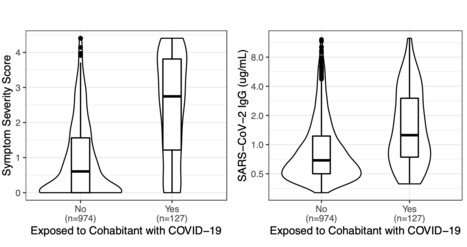Vaccination and Household Transmission of SARS-CoV-2 In this study involving household contacts of persons with laboratory-confirmed Covid-19, the risk of household transmission was 40 to 50 lower in households of index patients who had been vaccinated 21 days or more before testing positive than in households of unvaccinated index patients.
Vaccination against severe acute respiratory syndrome coronavirus 2 (SARS-CoV-2) prevents infection and reduces the severity of coronavirus disease 2019 (Covid-19) in vaccinated persons.1,2 We investigated whether vaccination would reduce transmission in the household setting in the context of postvaccination infection. We analyzed data from the Household Transmission Evaluation Dataset (HOSTED), which has information on all laboratory-confirmed cases of Covid-19 in England and in which data on all persons sharing the same address are linked.3 We then linked to individual-level data on all Covid-19 vaccinations in England (see the Methods section in the Supplementary Appendix, available with the full text of this letter at NEJM.org). We compared the risk of secondary infection (defined as a positive SARS-CoV-2 test 2 to 14 days after the positive test for the index case) among unvaccinated household contacts of persons with SARS-CoV-2 infection who had received at least one dose of the ChAdOx1 nCoV-19 or BNT162b2 vaccine 21 days or more before testing positive with the risk among unvaccinated household contacts of unvaccinated persons with infection. We fitted logistic-regression models with adjustment for the age and sex of the person with the index case of Covid-19 (index patient) and the household contact, geographic region, calendar week of the index case, deprivation (a composite score of socioeconomic and other factors), and household type and size. We also considered the timing of effects among index patients who had been vaccinated at any time up to the date of the positive test.
Between January 4 and February 28, 2021, there were 960,765 household contacts of unvaccinated index patients, and there were 96,898 secondary cases of Covid-19 (10.1%). (Descriptive data regarding the index patients and their household contacts are provided in the Summary Results section.) The numbers of secondary cases according to the vaccination status of the index patient, and the results of logistic-regression models, are shown in Table 1. Overall, the likelihood of household transmission was approximately 40 to 50% lower in households of index patients who had been vaccinated 21 days or more before testing positive than in households of unvaccinated index patients; the findings were similar for the two vaccines. Most of the vaccinated index patients in our data set (93%) had received only the first dose of vaccine. Assessment of infection risks among household contacts according to the timing of vaccination of the index patient showed protective effects when the vaccine had been administered at least 14 days before the positive test (Figs. S1 and S2 in the Supplementary Appendix)....
Published in NEJM (June 23, 2021):



 Your new post is loading...
Your new post is loading...









